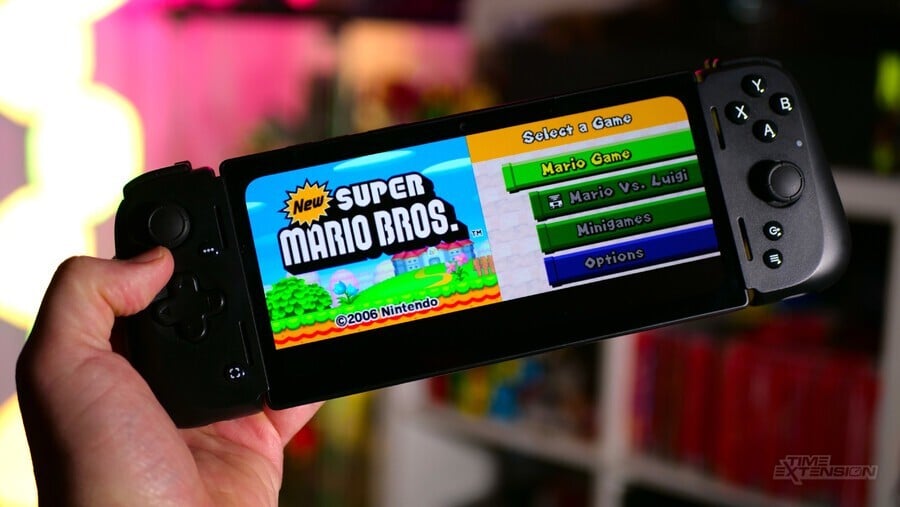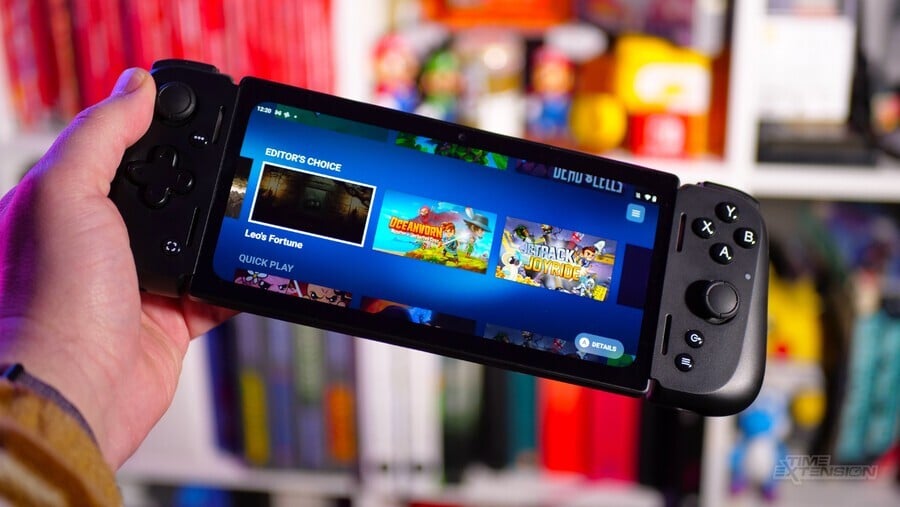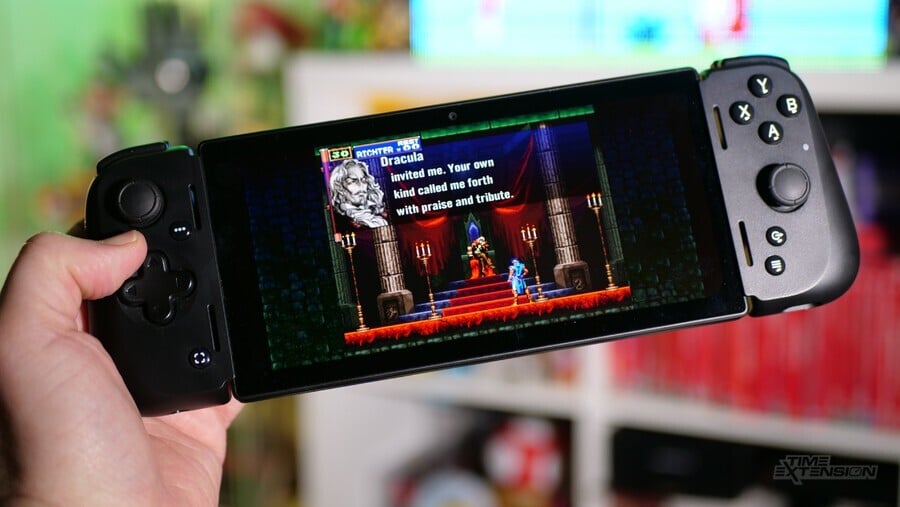
Android-based gaming handhelds are becoming increasingly popular, and with good reason; Google's OS benefits from years of development, has a vast array of games and emulators available for it and is backed by some seriously impressive hardware, such as Qualcomm's Snapdragon G3X series of chips.
We've already been impressed with the likes of the AYN Odin 2 and AYANEO Pocket S, but we're circling back somewhat with the Razer Edge ($399.99), which launched at the start of last year.
What makes this particular device unique is that it comes with a detachable control setup, which allows it to behave like a small Android tablet when you're not gaming. However, with the competition hotting up in 2024, is this 2023 challenger still worth a look? Join us as we find out...
Razer Edge Review: Design & Display

When you first take the Razer Edge out of the box, it looks like a large smartphone. It's effectively a big slab of plastic dominated by a roomy 6.8-inch AMOLED screen. However, nestled beneath the device in the packaging is the Kishi V2 Pro controller, which bolts onto the Edge using a spring-loaded system and USB-C. When the pair are united, they create a powerful Android-based gaming system with an absolutely top-tier physical interface.
It's worth stressing just how good the Kishi feels to use – and it's also worth pointing out that its usefulness is not limited entirely to the Edge; it can fit other devices, too. It boasts responsive buttons and a great (if slightly clicky) cross-shaped D-pad, as well as twin analogue sticks and an array of shoulder buttons.
The catch here is that when the Kishi V2 is connected to the Edge, it makes it quite awkward to carry around with you, as the pair never feel as robustly mated as a traditional handheld games console would. There's still a little bit of movement, despite the strong grip of that aforementioned spring-loaded mechanism, and we certainly didn't feel brave enough to sling it in our bag to take out of the house with us. Finding a carry case which fits a device of this size is also tricky.
We also have to say that the process of getting the Razer Edge in and out of the Kishi V2 can often be quite fraught; even when fully extended, there never feels like there's quite enough room to properly manoeuvre the device into the Kishi V2's grip without the risk of bending the USB-C connector.
The upside to this arrangement is that when you're not gaming, you can ditch the Kishi V2 and simply use the Razer Edge as you would a smartphone or tablet, and we'd imagine there are quite a few people out there who would see merit in having this choice. It also means you can swap out the Kishi V2 for a replacement interface, if you so wish.
The Razer Edge's screen is perhaps one of the most striking things about the device; the 6.8-inch 1080p AMOLED panel has a 144Hz refresh rate, which is above and beyond what most rival Android gaming handhelds can offer – although finding content which supports it is a challenge. The 20:9 aspect ratio results in a long, thin viewing area, and to be brutally honest, many games don't make the most effective use of it. We're also not too fond of the rounded corners, either – they cut off some of the viewing area unnecessarily.
Despite these issues, we love the Razer Edge's screen – especially after spending so much time with the AYANEO Pocket S, which has an IPS display that, while good, isn't a patch on this when it comes to brightness, vibrancy, and contrast.
Razer Edge Review: Software & Performance

Because it's running Android 13, the Razer Edge behaves very much like your typical smartphone or tablet when it's not playing games. You can download all of the usual apps, surf the web, send messages and even compose emails – anything your phone can do, this can do, too.
The Razer Nexus app is an attempt to create a hub for all of your gaming activities, and it's moderately successful; it does a good job of pulling in all of your gaming-related apps in one place, removing some of the often aimless scrolling you need to do in order to navigate through the Android UI. If you're not a fan, then it's easy to ignore, and doing so certainly doesn't limit you in any way.
There's enough raw power on tap here to make short work of pretty much any native Android game, as well as provide a capable platform for retro emulation. GameCube, Wii, PS2 and Dreamcast all run well (with some requiring a little more tinkering than others), and any system prior to those is also going to run flawlessly on this device.
Razer has made a big deal out of this device's ability to stream games from other systems and has used apps like Xbox Cloud Gaming, Steam Link, Nvidia GeForce Now, and PS Remote Play in its promotional activity for the Edge. The truth is, all modern Android devices are capable of this kind of thing, so the Razer Edge isn't unique in its embrace of cloud gaming – what makes the difference here is that the dedicated controls make things a lot more enjoyable than they would normally be on a device which relies entirely on the touchscreen for input.
There are two variants available in terms of connectivity; the one we're reviewing here is the WiFi-only version, but a 5G-compatible edition is also available (for a slightly higher price), which allows you to insert a SIM card and get a wireless connection even when you're out of the house.
Razer Edge Review: Conclusion

While the playing field has changed a little in the year or so since the Razer Edge launched, it hasn't really been outclassed in terms of processing power. The recently-released AYANEO Pocket S has a second-gen Snapdragon G3X, but it's not as if this device is suddenly left in the dust – the first-gen chipset is still a beast when it comes to gaming and emulation.
The Razer Edge also benefits from a fantastic display with a high refresh rate, and its audio capabilities are also top-notch. The bundled Kishi V2 Pro controller is also quite a big selling point, especially for those looking for console-quality controls in their Android-based handheld.
On the downside, the Kishi V2, when combined with the Edge, doesn't give the robust feel many people will expect from their portable gaming system. Sure, the upside is that you can use the Kishi V2 with other devices – and use the Edge as a mini-tablet when you're not gaming – but the whole thing never really gels as a complete package. We'd rather have seen Razer simply create an all-in-one console, if we're honest.
Still, given its age, it's possible to pick up the Razer Edge for less than its $400 starting price these days, making it easier to recommend. While it's not perfect, there's a lot of power on display here, and if you're on the lookout for an Android gaming solution with a great screen and the grunt to run pretty much everything you can throw at it, then this might just fit the bill.






Comments 6
rounded display corners? absolutely not.
Aspect ratio leaves something to be desired for emulation in my opinion, and I also can't help but still have the RAM controversy leave a bad taste in my mouth, particularly because they didn't even apologize if I remember correctly, they just quietly updated the RAM info on their website. Cool hardware overall, but for a few reasons I find it hard to recommend, personally.
@-wc- It's an odd choice, for sure. I'm not sure what they were thinking.
Perhaps ironically, this went down to £266 on Amazon, so I got one as a late birthday present, so far it's pretty slick but feels very delicate (for reference I've been using an Anbernic RG-Arc up until now, and that feels like a toy in comparison). It turned up today!
Already tried this on my local mall, I don't like android as operating system for emulation (prefer fpga). I wish razer can make steam deck competitor with this design since steam deck is too bulky.
I would take a rounded screen on a 4:3 display but that’s unhelpful for widescreen content
Leave A Comment
Hold on there, you need to login to post a comment...